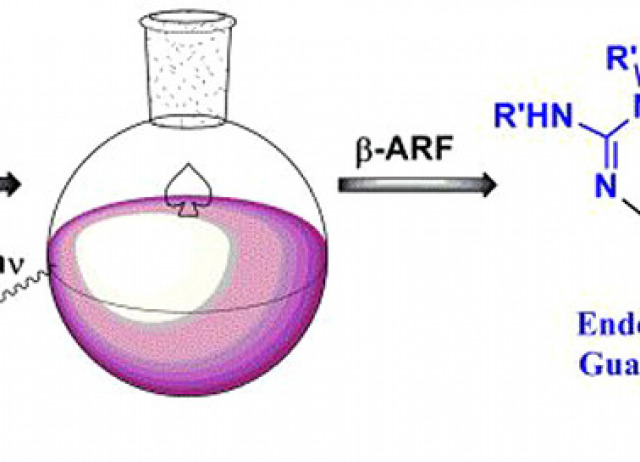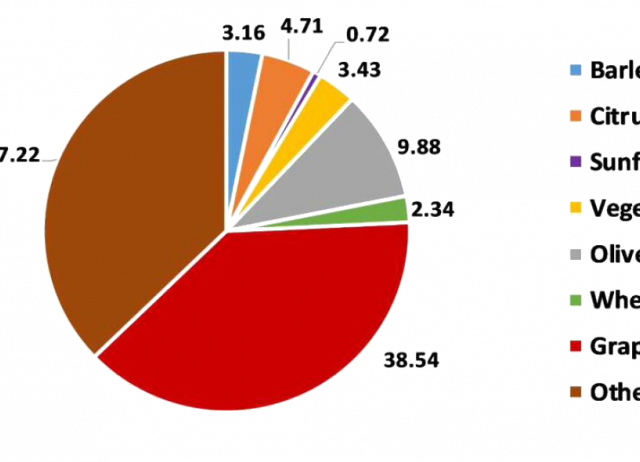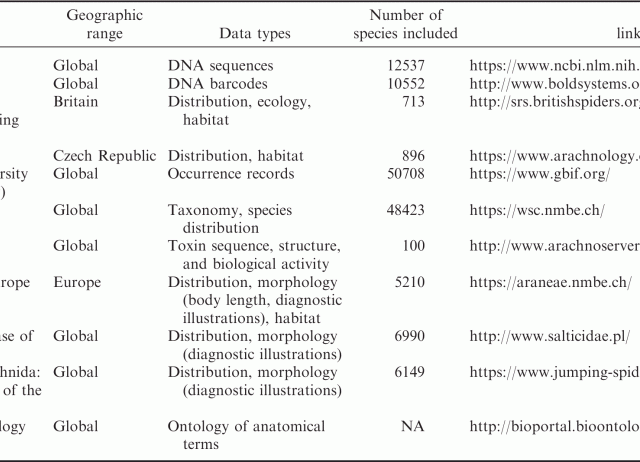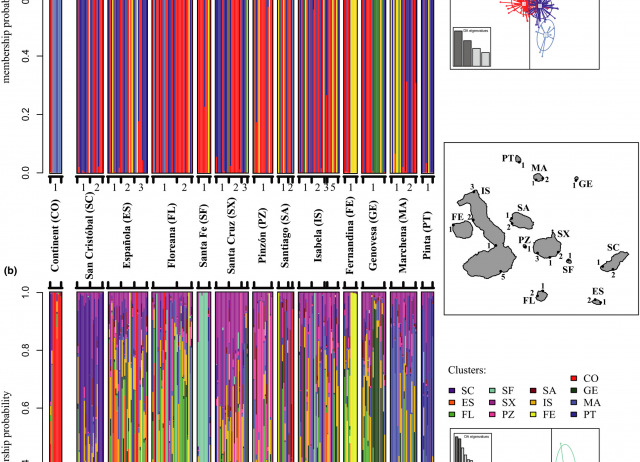
Tandem Radical Fragmentation/Cyclization of Guanidinylated Monosaccharides Grants Access to Medium-Sized Polyhydroxylated Heterocycles
The fragmentation of anomeric alkoxyl radicals (ARF) and the subsequent cyclization promoted by hypervalent iodine provide an excellent method for the synthesis of guanidino-sugars. The methodology described herein is one of the few existing general methodologies for the formation of medium-sized exo- and endoguanidine-containing heterocycles presenting a high degree of oxygenation in their structure.
Santana, Andrés G.; González Martín, Concepción C.
Big sales, no carrots: Assessment of pesticide policy in Spain
This paper explores Spanish pesticide policy with a focus on developments during the last decade. Spain is one of the greatest global consumers of conventional pesticides and leader in various related rankings among European Union countries. However, reviews of pesticide policies examining the key plans, facts, strategies and stakeholders are largely lacking. In providing an overview of Spanish responses to the European Directive 2009/128/EC on the Sustainable Use of Pesticides, this article contributes to filling this research gap. Spanish National Action Plans lack measurable quantitative objectives for reduction in the use of conventional pesticides and further implementation of Integrated Pest Management. Spanish National Action Plans also lack strategies for informing citizens about pesticide residues, and efficient means of keeping up to date with the authorisation of new active substances and delivery of pesticide use and sales data, in time and form. Moreover, there are no clear trends in conventional pesticide use reduction and sales, despite a significant reduction in the use of the more toxic active substances. Overall, this paper reveals various important shortcomings and incongruences in Spanish pesticide policy, which deserve further scholarly exploration and should be a matter of concern for public bodies.
Alonso-González, Pablo; Parga-Dans, Eva; Pérez Luzardo, Octavio
First record of intertidal oribatid mites (Acari, Oribatida) from the Canaries – a new species and its complete ontogeny
A new species of intertidal oribatid mites from Tenerife is described and its full ontogenetic development is given in detail. Thalassozetes canariensis sp. nov. can easily be distinguished from its congeners by its characteristic notogastral cuticular pattern showing loosely distributed irregular elevations, and its rectangular median sternal cavity. Based on morphology, Thalassozetes canariensis sp. nov. is most closely related to the Mediterranean T. riparius; both species share a small transversal band-like notogastral light spot and the longitudinal orientation of lyrifissure iad. The juvenile morphology of T. canariensis sp. nov. conforms basically to those of known Thalassozetes juveniles but there are discrepancies in certain aspects that require further research into all known species. This report of T. canariensis sp. nov. from Tenerife is the first record of an intertidal mite for the Canaries, and also for the Eastern Atlantic area. Further records of this species within the area may be expected.
Pfindstl, Tobias; De la Paz, Juan Carlos; Hernández-Teixidor, David
Self-compatibility in peach [Prunus persica (L.) Batsch]: patterns of diversity surrounding the S-locus and analysis of SFB alleles
Self-incompatibility (SI) to self-compatibility (SC) transition is one of the most frequent and prevalent evolutionary shifts in flowering plants. Prunus L. (Rosaceae) is a genus of over 200 species most of which exhibit a Gametophytic SI system. Peach [Prunus persica (L.) Batsch; 2n = 16] is one of the few exceptions in the genus known to be a fully selfcompatible species. However, the evolutionary process of the complete and irreversible loss of SI in peach is not well understood and, in order to fill that gap, in this study 24 peach accessions were analyzed. Pollen tube growth was controlled in self-pollinated flowers to verify their self-compatible phenotypes. The linkage disequilibrium association between alleles at the S-locus and linked markers at the end of the sixth linkage group was not significant (P > 0.05), except with the closest markers suggesting the absence of a signature of negative frequency dependent selection at the S-locus. Analysis of SFB1 and SFB2 protein sequences allowed identifying the absence of some variable and hypervariable domains and the presence of additional α-helices at the C-termini. Molecular and evolutionary analysis of SFB nucleotide sequences showed a signature of purifying selection in SFB2, while the SFB1 seemed to evolve neutrally. Thus, our results show that the SFB2 allele diversified after P. persica and P. dulcis (almond) divergence, a period which is characterized by an important bottleneck, while SFB1 diversified at a transition time between the bottleneck and population expansion.
Abdallah, Donia; Baraket, Ghada; Pérez Méndez, Verónica: Hannachi, Amel Salhi; Hormaza, José I.
Towards establishment of a centralized spider traits database
A main goal of ecological and evolutionary biology is understanding and predicting interactions between populations and both abiotic and biotic environments, the spatial and temporal variation of these interactions, and the effects on population dynamics and performance. Trait-based approaches can help to model these interactions and generate a comprehensive understanding of ecosystem functioning. A central tool is the collation of databases that include species trait information. Such centralized databases have been set up for a number of organismal groups but is lacking for one of the most important groups of predators in terrestrial ecosystems – spiders. Here we promote the collation of an open spider traits database, integrated into the global Open Traits Network. We explore the current collation of spider data and cover the logistics of setting up a global database, including which traits to include, the source of data, how to input data, database governance, geographic cover, accessibility, quality control and how to make the database sustainable long-term. Finally, we explore the scope of research questions that could be investigated using a global spider traits database.
Lowe, Elizabeth C.; Wolff, Jonas O.; Aceves-Aparicio, Alfonso; Birkhofer, Klaus; Veiga Branco, Vasco; Cardoso, Pedro; Chichorro, Filipe; Fukushima, Caroline Sayuri; Gonçalves-Souza, Thiago; Haddad, Charles R.; Isaia, Marco; Krehenwinkel, Henrik; Audisio, Tracy Lynn; Macías-Hernández, Nuria; Malumbres-Olarte, Jagoba; Mammola, Stefano; McLean, Donald James; Michalko, Radek; Nentwig, Wolfgang; Pekár, Stano; Pétillon, Julien; Privet, Kaïna; Scott, Catherine; Uhl, Gabriele; Urbano-Tenorio, Fernando; Wong, Boon Hui; Herberstein, Marie E.
Biogeography and integrative taxonomy of Epipterygium (Mniaceae, Bryophyta)
A significant number of bryophyte species are thought to have transcontinental geographic ranges, often with multiple disjunct distribution areas. One of these cases is Epipterygium tozeri (Mniaceae), with a Holarctic distribution and disjunct ranges in western North America, the Mediterranean, Japan and central Asia. Collections from different geographic regions were lumped into E. tozeri based on morphology, but a molecular confirmation was lacking so far. Here, we tested species concepts in the genus Epipterygium, with a special focus on the E. tozeri species complex, combining morphological and DNA sequence data for the nuclear ribosomal ITS region and two plastid loci (trnG intron, trnT‐psbD spacer). In a second step, we reconstructed the historical biogeography of the genus. We found that Epipterygium most likely originated in Asia or North/Central America and that the alleged single widespread species E. tozeri with disjunct ranges is in fact a group of genetically and morphologically distinct taxa, including four overlooked species, for which we provide descriptions: E. atlanticum sp. nov., E. biauritum sp. nov., E. oreophilum sp. nov., and E. yunnanense sp. nov. The biogeographical history of these species is best explained by a step‐wise parallel colonization of the Eurasian and American continents followed by in‐situ speciation.
Hanusch, Maximilian; Ortiz, Edgardo M.; Patiño, Jairo; Schaefer, Hanno
Linking seascape with landscape genetics: Oceanic currents favour colonization across the Galápagos Islands by a coastal plant
Aim
Coastal plants are terrestrial organisms for which ocean surface currents often act as long‐distance dispersal vectors (thalassochorous species) favouring broad distributions and connecting distant populations. However, few studies have statistically assessed the role of currents in modulating gene flow and species distributions of terrestrial organisms. Here we evaluate the hypothesis that some thalassochorous plants exhibit population connectivity, presumably due to effective seed dispersal driven by sea currents.
Location
Galápagos Islands (Ecuador).
Taxon
Salt bush (Cryptocarpus pyriformis Kunth), a Galápagos native and locally widespread coastal angiosperm.
Methods
Using 1806 SNPs obtained by ddRADseq, we evaluated the genetic structure and differentiation of the Galápagos salt bush. To assess the role of sea currents in modulating inter‐population gene flow, four explicit hypotheses were tested using reciprocal causal modelling and spatial eigenvector analysis: (a) isolation by sea resistance, considering that only sea dispersal is possible; (b) isolation by sea and inland resistance, considering that inland dispersal is also possible; (c) isolation by barrier, considering the sea as an obstacle to seed dispersal; and (d) isolation by geographical distance.
Results
Low differentiation and little genetic structure were detected among populations of C. pyriformis. Pairwise genetic distances between populations from different islands were significantly correlated with cost distances calculated from sea‐current direction and speed. Nonetheless, inland dispersal also accounted for some gene flow within each island.
Main conclusion
Extensive and frequent seed dispersal by sea has apparently favoured strong inter‐island genetic connectivity within Galápagos. A combination of methods developed for terrestrial and marine domains (landscape and seascape genetics) aids in understanding how landscape features modulate gene flow of coastal plant species, as these terrestrial organisms are highly dependent on the sea for seed dispersal.
Arjona, Yurena; Fernández-López, Javier; Navascués, Miguel; Álvarez, Nadir; Nogales, Manuel; Vargas, Pablo
Vino de Tea (pine heartwood wine) from La Palma (Spain): ethnographic and physic-chemical characterization of a unique fermented product
This paper presents the results of a novel study of Vino de Tea (pine heartwood wine) from the island of La Palma (Canary Islands, Spain). The aim is to investigate its differential characteristics and contribute to typifying it within the Denomination of Origin ‘Wines of La Palma’. The analysis is based on a mixed approach combining a qualitative ethnographic approach (22 interviews) and quantitative physic-chemical methods in a sample of 16 wines. The ethnographical study revealed the tradition and techniques of elaboration behind Vino de Tea. In turn, the physic-chemical analysis revealed by chromatography a significant presence of α-terpineol due to elaboration in pine barrels or casks. These samples were compared with a Greek Retsina wine, revealing the differences between these two traditional wines. These data suggest that Vino de Tea is a unique product with distinctive characteristics and potential health benefits, owing to its significant content of α-terpineol resulting from its fermentation in Canary pine casks.
Alonso-González, Pablo; Parga-Dans, Eva
Displacements Monitoring over Czechia by IT4S1 System for Automatised Interferometric Measurements using Sentinel-1 Data
The Sentinel-1 satellite system continuously observes European countries at a relatively high revisit frequency of six days per orbital track. Given the Sentinel-1 configuration, most areas in Czechia are observed every 1–2 days by different tracks in a moderate resolution. This is attractive for various types of analyses by various research groups. The starting point for interferometric (InSAR) processing is an original data provided in a Single Look Complex (SLC) level. This work represents advantages of storing data augmented to a specifically corrected level of data, SLC-C. The presented database contains Czech nationwide Sentinel-1 data stored in burst units that have been pre-processed to the state of a consistent well-coregistered dataset of SLC-C. These are resampled SLC data with their phase values reduced by a topographic phase signature, ready for fast interferometric analyses (an interferogram is generated by a complex conjugate between two stored SLC-C files). The data can be used directly into multitemporal interferometry techniques, e.g., Persistent Scatterers (PS) or Small Baseline (SB) techniques applied here. A further development of the nationwide system utilising SLC-C data would lead into a dynamic state where every new pre-processed burst triggers a processing update to detect unexpected changes from InSAR time series and therefore provides a signal for early warning against a potential dangerous displacement, e.g., a landslide, instability of an engineering structure or a formation of a sinkhole. An update of the processing chain would also allow use of cross-polarised Sentinel-1 data, needed for polarimetric analyses. The current system is running at a national supercomputing centre IT4Innovations in interconnection to the Czech Copernicus Collaborative Ground Segment (CESNET), providing fast on-demand InSAR results over Czech territories. A full nationwide PS processing using data over Czechia was performed in 2017, discovering several areas of land deformation. Its downsampled version and basic findings are demonstrated within the article.
Lazecký, Milan: Hatton, Emma; González, Pablo J.; Hlavácová, Ivana; Jiránková, Eva; Dvorák, Frantisek; Sustr, Zdenek, Martinovic, Jan
Revealing community assembly through barcoding: Mediterranean butterflies and dispersal variation
In Focus: Scalercio, S., Cini, A., Menchetti, M., Vodă, R., Bonelli, S., Bordoni, A., … Dapporto, L. (2020). How long is 3 km for a butterfly? Ecological constraints and functional traits explain high mitochondrial genetic diversity between Sicily and the Italian Peninsula. Journal of Animal Ecology. https://doi.org/10.1111/1365‐2656.13196. Biotic and abiotic factors can shape geographical patterns of genetic variation within species, but few studies have addressed how this might generate common patterns at the level of communities of species. Scalercio et al. (2020) have combined mtDNA sequence data and life‐history traits, to reveal a repeated pattern of genetic structure between Sicilian and southern Italian butterfly populations, which are separated by only 3 km of ocean. They reveal how intrinsic species traits and extrinsic environmental constraints explain this pattern, demonstrating an important role for wind. Moreover, the inclusion of almost 8,000 georeferenced sequences reveals that, in spite of also being present in southern Italy, almost half of Sicilian butterfly species are more closely related to populations from other parts of Europe, Asia or North Africa. We provide further discussion on the biogeographic barrier they identify, and the potential of community‐level DNA barcoding to identify processes that structure genetic variation across communities.
Emerson, Brent C.; Jiménez-García, Eduardo; Suárez, Daniel


